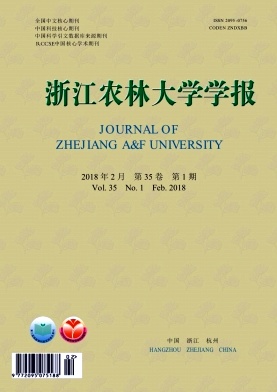-
中国常见白蚁Termitida主要有台湾乳白蚁Coptotermes formosanus,黄胸散白蚁Reticulitermes flaviceps,黑胸散白蚁Reticulitermes chinensis,黑翅土白蚁Odontotermes formosanus,截头堆砂白蚁Cryptotermes domestictis等。这些白蚁广泛分布于温带和热带,以木质纤维素为食,主要危害树木、各类木制品和纸张、布匹等含纤维素的物质,对园林植被、建筑物和堤坝造成严重危害[1]。浙江地区雨水充足,气候温暖湿润,非常适宜白蚁生存繁衍,其中台湾乳白蚁、黄胸散白蚁、黑翅土白蚁、黄翅大白蚁Macrotermes barneyi等对人类生活影响较大[2]。药剂防治作为传统的白蚁灭治方法,因对环境影响较大,近年来已逐渐转变为环境友好的监测控制技术;使用药物也由持久性有机污染物氯丹和灭蚁灵转变为对环境危害较小的拟除虫菊酯类和昆虫生长调节剂等药剂[3-4]。监测控制技术以食物诱集为前提,通过投放饵剂达到整巢灭治白蚁的目的;该技术降低了药剂的使用量,减少了药物的使用面积,减轻对环境的污染,同时具有控制时间长、针对性强的优点,在白蚁防治中得到广泛应用[4-5]。监测控制技术所用饵剂由引诱白蚁的饵料和有效灭治白蚁的药剂组成。以白蚁喜食的木材(松木、桉树皮等)、纤维素粉、小米粉、甘蔗等作为引诱剂,可对白蚁产生较好的诱集作用[6-9]。在灭治药剂的选择上,要求无明显的驱避作用且在白蚁回避浓度以下,同时要求药性缓慢,药剂逐步传递到群体内,从而灭治整个巢群。常用药剂有神经毒类如氟虫腈,代谢抑制物类如氟虫胺和氟蚁腙,几丁质合成抑制剂类如氟铃脲、多氟脲等;不同药剂的灭治效果会因地域和白蚁种类的不同而有较大差异[10]。饵剂中添加氨基酸、糖、二氧化碳、木薯等可增加白蚁的喜食性,加强药效[11-13],但在实际应用中,饵剂可能会出现药效缓慢、衰减、易霉变、被其他地下昆虫(如金环马陆Spirobolus bungii)取食等问题,同时饵剂的投放位点、数量、大小和对饵剂的检查和更换时间也会影响诱杀效果[8, 14]。因此,研制白蚁喜食而又持久耐用的饵料和有效灭治白蚁的药剂是监测与诱杀白蚁的关键。为得到引诱效果持久、不易霉变、使用方便的白蚁监控饵料,本研究比较了台湾乳白蚁对不同饵料的取食选择性,为研制诱集效果好、灭治药效强的新型白蚁饵剂提供基础。
HTML
-
供试昆虫台湾乳白蚁取自杭州市白蚁防治研究所白蚁养殖室,松木饲养6 a。饵料主要成分为桉树皮、松木和纤维素,饵剂是在饵料的基础上加入虫螨腈。
-
将桉树树皮、松木烘干,经流水式高速中药粉碎机(DF-20,温岭市林大机械有限公司)粉碎后,与纤维素粉(浙江中维药业有限公司)按m(木粉):m(纤维素粉)=9:1的比例混合均匀,加水揉搓成直径约为5 cm的球状,置于60 ℃烘箱中干燥15 h后,制成松纤饵料或桉纤饵料。同时将纯纤维素粉加水制成纯纤饵料。饵料用封口袋保存,待野外试验时取出,压制成7.0 cm × 7.0 cm × 1.0 cm的块状。
-
将纯度为94.5%的虫螨腈原粉(巴斯夫公司,德国)用丙酮溶解,按100 μg·g-1添加到纯纤饵料、松纤饵料和桉纤饵料中,配制成含虫螨腈的松纤饵剂、桉纤饵剂和纯纤饵剂。
-
准备直径15.0 cm,深度2.0 cm的圆形玻璃皿,皿中铺0.5 cm厚的吸水蛭石。准确称取松木块(对照)、纯纤饵料、松纤饵料和桉纤饵料各1.0 g,对称放入玻璃皿中;在皿中间处放入300头工蚁和30头兵蚁。盖上皿盖,将玻璃皿置于黑暗条件、温度(27±1) ℃的培养箱内。1周后检查,将剩余饵料烘干并称取质量,计算出取食质量。试验设重复6次·处理-1。
-
试验装置(玻璃皿)同上,准确称取纯纤饵料(对照)、纯纤饵剂、松纤饵剂和桉纤饵剂各1.0 g,放入皿中;放入50头工蚁和5头兵蚁。盖上皿盖,将玻璃皿置于黑暗、温度为(27±1) ℃的培养箱内5 d。重复5次·处理-1。
-
在杭州市白蚁防治研究所办公楼楼下的无遮挡草坪覆盖区挖坑,尺寸为25.0 cm × 12.0 cm × 10.0 cm;放入装有纯纤饵料(对照)、纯纤饵剂、松纤饵剂和桉纤饵剂的带孔长方形塑料盒,上盖后覆土。埋设1个月后取出,按1.3.1方法进行药效试验。
逐日记录工蚁个体死亡数,计算死亡率与校正死亡率。死亡率=(死虫数/供试虫数)×100%;校正死亡率=(处理死亡率-对照死亡率)/(100-对照死亡率)×100%。
-
选取园林绿地和房屋建筑为试验点。将纯纤饵料放入带孔的塑料盒内做成纤维素装置,在公园绿化树木周围(1棵树木周围埋设1个饵料装置)和距离房屋建筑1.0 m处(饵料装置相距至少5.0 m)埋设装置,隔1个月打开装置观察,对己取食完全或毁坏严重的饵料进行补充,连续8个月观察并记录饵料被取食情况和霉变情况。
-
应用DPS软件对试验结果进行分析。百分数进行反正弦平方根转换,采用方差分析检验取食量和死亡率[15],P<0.05为差异显著。
1.1. 供试昆虫、饵料制取与饵剂制备
1.1.1. 饵料制备
1.1.2. 饵剂制备
1.2. 台湾乳白蚁对饵料的取食选择性测定
1.3. 不同纤维素饵剂对台湾乳白蚁的药效试验
1.3.1. 室内药效试验
1.3.2. 室外埋设处理后药效试验
1.4. 纤维素装置的野外使用效果测定
1.5. 数据处理
-
试验7 d后,测定台湾乳白蚁对松木块、纯纤饵料、松纤饵料和桉纤饵料的取食选择性(表 1)。结果表明,台湾乳白蚁对纯纤饵料的取食量显著多于松纤饵料和松木块(P<0.05),与桉纤饵料相比无显著差异(P>0.05)。试验7 d中,各处理饵料和木块均未出现霉变,且均未有白蚁死亡;与松木块相比,台湾乳白蚁更喜取食纯纤饵料。
饵料类型 取食量/(mg•头-1) 纯纤饵料 1.18±0.09 a 桉纤饵料 1.04±0.17 ab 松纤饵料 0.70±0.14 b 松木 0.24±0.02 c 说明:表中数据为平均数±标准误。数据后不同字母表示差异显著(P < 0.05)。 Table 1. The comparison of the food consumption of Coptotermes formosanus feeding with 4 kinds of baits
-
将3种纤维素饵剂用于台湾乳白蚁的室内药效试验(表 2)。结果表明,在第1天,3个饵剂造成的白蚁死亡率均较小;第2天,台湾乳白蚁取食桉纤饵剂后的死亡率显著大于松纤饵剂(P<0.05);到第3天,3个饵剂下的白蚁均出现大量死亡(死亡率>50%),其中取食纯纤饵剂的死亡率显著大于松纤饵剂(P<0.05);到第5天,所有试验组白蚁死亡率均达到或接近100%。
饵剂类型 死亡率/% 第1天 第2天 第3天 第4天 第5天 纯纤饵剂 6.40±1.33 ab 54.40±3.66 ab 64.18±2.83 a 95.20±2.06 a 100.00±0.00 a 桉纤饵剂 10.00±1.10 a 57.20±3.72 a 60.61±2.36 ab 90.00±6.32 a 100.00±0.00 a 松纤饵剂 5.20±1.62 b 43.00±4.07 b 54.38±1.30 b 87.60±4.07 a 97.20±1.96 a 说明:表中数据为平均数±标准误。数据后不同字母表示差异显著(P < 0.05)。 Table 2. Corrected mortalities of 3 cellulose baits against workers of C. formosanus by contact toxicity
对埋设1个月后的饵剂重复室内药效试验(表 3)。结果表明:第1天,3个饵剂造成的的白蚁死亡率均小于10%,第3天起,3个饵剂下的白蚁均出现大量死亡(死亡率>50%),第1~3天,台湾乳白蚁取食纯纤饵剂后的死亡率显著大于松纤饵剂(P<0.05);到第5天,3个饵剂下的白蚁死亡率均接近100%。与未埋设的饵剂相比,室外埋设1个月的饵剂对台湾乳白蚁同样有较好的灭治效果。
饵剂类型 死亡率/% 第1天 第2天 第3天 第4天 第5天 纯纤饵剂 9.00±2.41 a 53.95±4.03 a 64.67±3.62 a 91.60±3.54 a 96.60±2.36 a 桉纤饵剂 5.20±l.62 ab 42.0l±4.08 ab 52.12±3.73 b 80.80±6.02 a 92.40±0.98 a 松纤饵剂 3.20±0.80 b 38.27±4.07 b 51.13±2.98 b 82.00±4.98 a 96.80±3.20 a 说明:表中数据为平均数±标准误。数据后不同字母表示差异显著(P < 0.05)。 Table 3. Corrected mortalities of three cellulose baits (buried for one month) against workers of C. formosanus by contact toxicity
-
试验于2015年3月将纤维素装置埋于园林绿地和房屋建筑周边,2015年10月取出,期间定期观察霉变情况、对白蚁的引诱效果和非靶标生物的进入情况。结果显示,在园林绿地内埋设的55个纤维素装置,均观察到黑翅土白蚁和黄翅大白蚁的取食痕迹,仅1处发现有金环马陆,未发现其他非靶标生物,观察期间未发现有饵料霉变现象;在房屋建筑周边埋设的22个纤维素装置,发现有2处被黄胸散白蚁取食,4处被金环马陆取食,未发现其他非靶标生物,观察期间未发现有饵料霉变现象。
2.1. 台湾乳白蚁对饵料的取食选择性测定
2.2. 不同纤维素饵剂对台湾乳白蚁的药效试验
2.3. 纤维素装置的野外使用效果测定
-
在监测控制技术中,饵料对于防治白蚁起到至关重要的监控作用,为能得到在野外保持长时间引诱效果,不影响药剂发挥作用,并且不易变质或失效的监控装置饵料,本试验比较了纤维素、松木和桉树皮作为饵料成分对引诱及灭治白蚁效果的影响。结果表明:较之于松木,台湾乳白蚁更喜食3种纤维素饵料,其中对纯纤饵料的取食量显著大于对松纤饵料的取食量(P<0.05),说明单一纤维素的饵料有更好的适口性。现国内的白蚁防治监控装置产品,多以木材为饵料,使用中需要大量的木材更换,不利于环保[15-16];而纤维素大量存在于自然界中,推广纤维素饵料可大大减少木材使用量,更加低碳环保[17]。药效试验发现,3种纤维素饵剂在经室外埋设处理1个月和未经室外埋设处理对台湾乳白蚁均产生了虽然缓慢但是有效的灭治效果。试验第1天白蚁死亡率较小,到第3天出现大量死亡(死亡率>50%),第5天白蚁的死亡率接近100%。虫螨腈对白蚁有慢性毒性和非趋避性[18-20],野外埋设处理并未影响到虫螨腈的灭治效果,与HAMM等[9]和EGER等[21]效果一致。3种纤维素饵剂造成的台湾乳白蚁死亡率之间存在差异,可能与供试白蚁对饵料的取食量不同有关。取食试验中,台湾乳白蚁对纯纤饵料的取食量多于桉纤饵料和松纤饵料,因此能够摄入较多的药剂,使得白蚁死亡率在前3 d的药效试验中表现出差异。
野外环境中,地下监控装置内的饵料或饵剂受温度和湿度的影响而发生霉变。有研究表明:添加质量分数为0.20%山梨酸钾或0.05%苯甲酸钠可延迟饵料发生霉变的时间,且不影响引诱效果[7, 22]。本研究发现,纤维素装置在野外环境8个月内未出现霉变,说明在不添加防霉变材料的情况下纤维素装置仍能长时间保证饵料的质量;减少饵料的更换,既增加了有效引诱时间,又降低了经济成本。另外,监测控制装置在使用时需要进行多次的检查,一方面检查是否引诱到白蚁,一方面确保饵料的完好。由于白蚁喜欢在黑暗隐蔽处活动,频繁的检查会对白蚁起到驱赶作用,减少白蚁的活动量,而不易霉变的纤维素可减少装置的检查次数,增加白蚁的活动频率,提高引诱效果[23]。野外环境复杂不可控,监控装置内或许会引入非靶标生物[7]。试验中的多数纤维素装置引诱到黑翅土白蚁、黄翅大白蚁和黄胸散白蚁,少数装置内的金环马陆暂未发现对引诱白蚁产生影响,但仍需对纤维素装置的野外使用进行更长时间的观察。
综上所述,纤维素作为白蚁饵料具有良好的适口性,在地下长期使用不易霉变,适合长期用于白蚁的监测控制技术。但该技术在使用过程中受环境影响,具有复杂多变的特点,对如何充分发挥饵剂的灭治效果,减少非靶标生物的进入,选择环境友好型的装置材料减少人为污染等还需进一步的研究。







 DownLoad:
DownLoad: